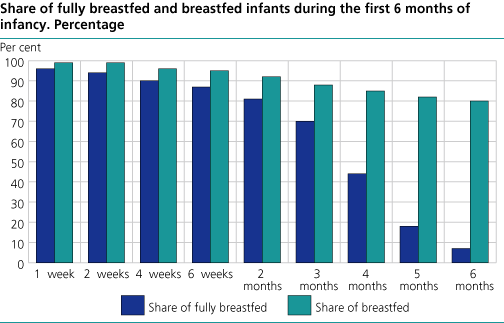Dietary survey among infants
Norwegian women breastfeed as recommended
Published:
Four out of five Norwegian infants are still breastfed at the age of six months. Just one per cent of the infants were never breastfed. This is shown by the first national survey on infantry nutrition in Norway.
The nation-wide dietary survey is carried out by Statistics Norway in cooperation with Directorate for Health and Social Affairs, The Norwegian Food Control Authority and Institute for Nutrition Research at the University of Oslo in 1998. The purpose of this survey was to examine infants' nutrition habits during the first 6 months.
Breast-feeding and dietary habits as recommended
Large shares of the infants have breastfeeding- and dietary habits as recommended for infant nourishment. A large share, 80 per cent of the infants, still get mother's milk at the age of six months, 70 per cent do not get anything else than mother's milk during the first 3 months, the majority have been introduced to heavy food after the age of 4 months and 80 per cent get vitamin D-contribution.
The period when the infant is given mother's milk as the only nourishment is shorter than recommended for many infants: At the age of 4 months, 44 per cent are only given mother's milk. When the survey was in progress it was recommended to give the infants mother's milk as the only nourishment until the age of 4-6 months, while it now is recommended to continue until the age of 6 months.
By the age of six months, 90 per cent of the children get porridge, and 63 per cent of them get dinner. Most of the infants that do not get mother's milk by the age of six months are given mother's milk substitution (36 per cent) instead of cow milk (1 per cent), as recommended. Using cod liver oil or other vitamin D- sources, is very common by the age of six months.
More breastfeeding among older, more educated women
In total the proportion of infants who are breastfed do not show any difference between boys and girls. On the other hand, there are differences in breastfeeding- and dietary habits following mother's age and education, whether she smokes or not, the number of children that she has, place of residence and the weight of the infant at birth. The share of breastfed infants increases with higher age and education level of mother, and with higher number of children.
More than 50 per cent want more information about infantry nutrition
Approximately 80 per cent of the participants felt they received useful or very useful information about breastfeeding and infant nourishment from the local health personnel and from their birth department. Other important sources of information were family, acquaintances and information material. More than half of the participants would like more information, especially about the introduction of heavy food, how to prepare food for the infants, and about food allergy or -intolerance.
Contact
-
Statistics Norway's Information Centre

